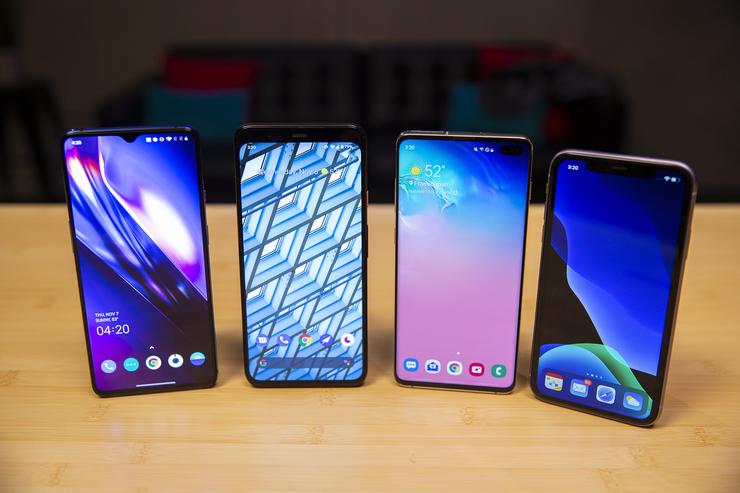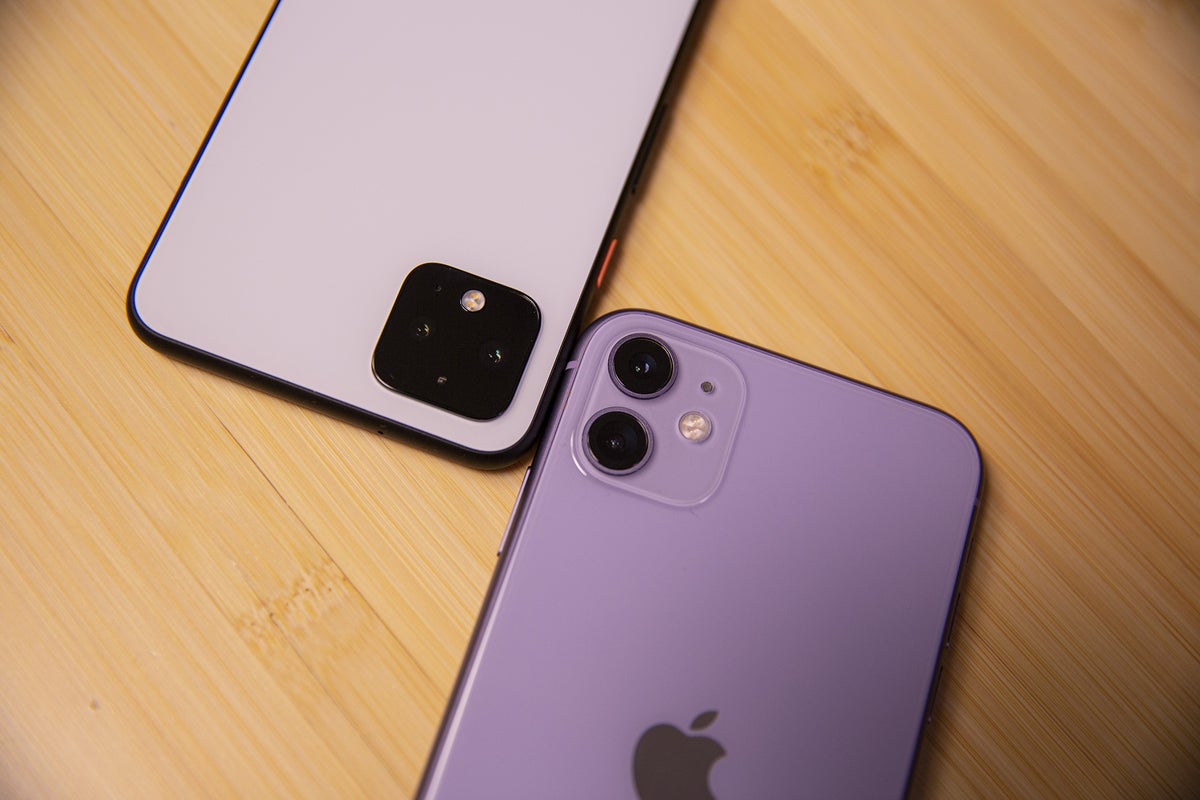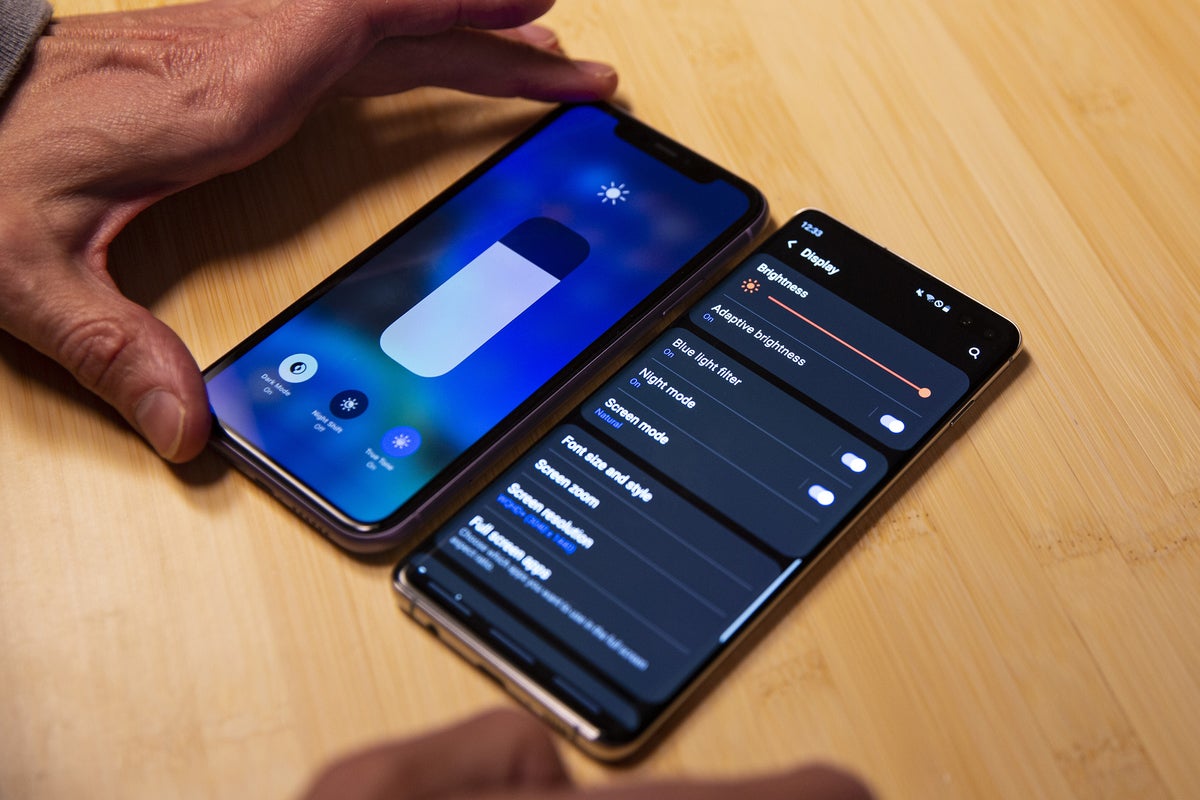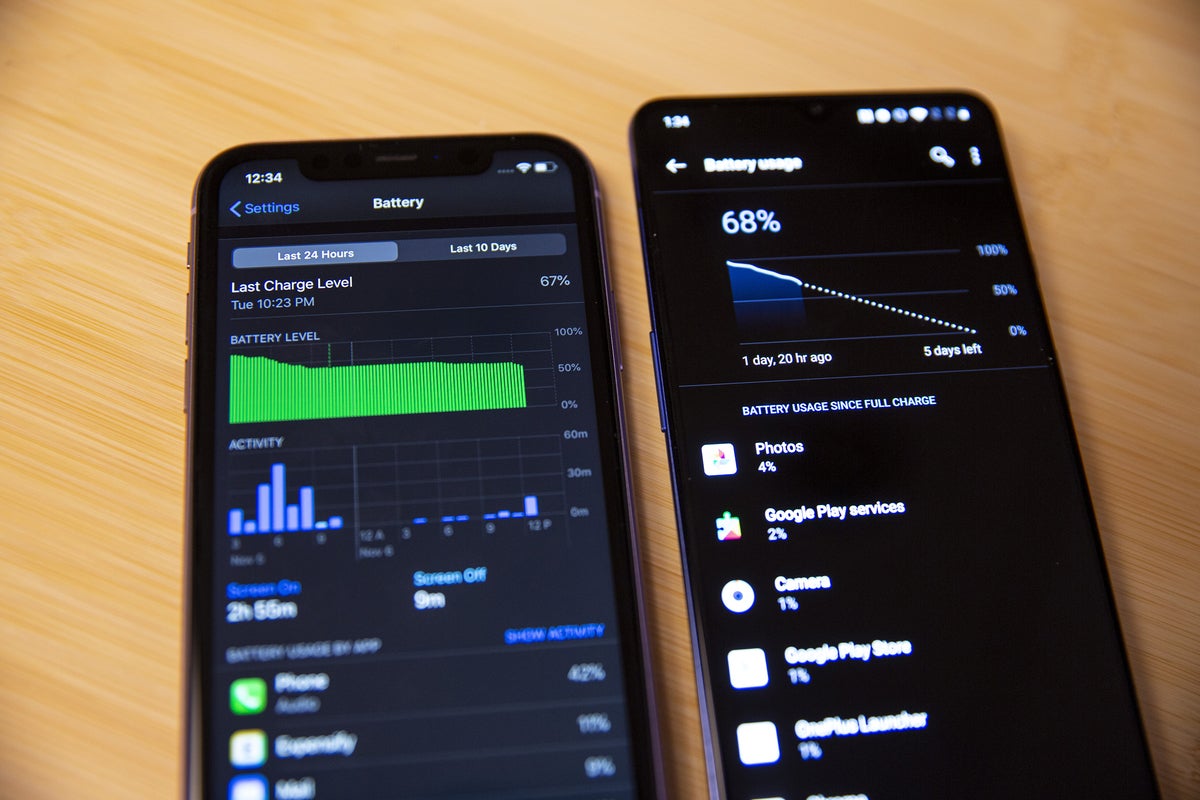 Credit: Christopher Hebert/IDG
Credit: Christopher Hebert/IDG
It’s time to compare Apple's iPhone to the leading Android handsets, and it should be a close race. From the launch of the first folding phone to the rise of 5G, dual screens, waterfall displays, and cameras, cameras, cameras, 2019 has delivered a dizzying array of new features. Apple may have surprised everyone with a price cut to its entry-level handset, but can it stack up to the best Android has to offer? Let's go through the major specs and find out.
The phones
Three phones compete against the iPhone 11 this year:
Galaxy S10+: I chose this model because it’s cheaper than the official flagship Note 10+. Also, compared to the S10, it's b) only $100 more, and c) equipped with a much bigger battery.
Pixel 4 XL: The newest phone has a laundry list of issues, but it gets it the nod over the smaller and cheaper Pixel 4 because of its better screen and bigger battery.
OnePlus 7T: OnePlus is on a roll. The two phones released in the United States in 2019, the 7 Pro and the 7T, raised expectations for what an affordable model can deliver. The newer 7T offers killer specs and a price that undercuts the iPhone 11's.
Design
While Samsung pushed design boundaries with an impressive reimagining of the Galaxy S10, the iPhone is starting to feel a little stale. It’s more symmetrical than the other phones here, but the notch, the thickish bezels, and the screen-to-body ratio leave much to be desired. It’s also the thickest of the bunch at 8.3mm.
The giant square camera is a polarizing look, and it makes the iPhone 11 wobble when it rests on a table. The camera bump matches your chosen handset color, and while he new purple and green are nice, the glossy back picks up fingerprints early and often. Rumors suggest that Apple may dump the notch and make other changes for the iPhone 12. I hope that’s the case.
 Christopher Hebert/IDG
Christopher Hebert/IDG
The Pixel 4 XL (left) and iPhone 11 have very similar camera stylings.
If the iPhone 11 is bland, the Pixel 4 XL is just plain blah. It loses last year’s notch for a sizable forehead, a small chin, and chunky side bezels. Like Apple, Google has added a square camera array in the upper left corner, but the Pixel 4’s bump is black regardless of body color.
I do like Google’s choice of materials, however. The luxurious frosted glass now covers the entire back of the phone, and it resists fingerprints, scratches, and smudges. The brushed-aluminum sides echo the frosted look, and the color options—which adds orange this year to the classics black and white—are appealing. I love the colored accent button. If Google ever decides to get serious about smartphone design, it should start with the materials and work backward.
 Christopher Hebert/IDG
Christopher Hebert/IDG
The Pixel 4’s orange power button remains my favorite feature about Google’s design.
Samsung's S10+ continues to refine the Galaxy look. The top and bottom bezels are barely-there slivers, bringing the screen-to-body ratio close to 90 percent, but it feels like more because the edges of the screen drape over the sides. The back of the S10+ is just as pleasing, with a horizontal camera array set against a glass available in fantastic colors. Yes, it’s a fingerprint magnet, but so is the iPhone's back. And unfortunately the lack of bezels brings visual and functional problems that Samsung isn’t yet prepared to address.
The oddball is the selfie camera. Lacking enough bezel to hide sensors, Samsung opted for a “hole-punch” camera literally embedded in the display, peering through a black circle in the upper right corner. Its off-center placement and funky design make it an eyesore.
 Christopher Hebert/IDG
Christopher Hebert/IDG
Surprisingly, the iPhone 11 (far right) is slightly thicker than the other phones here, but only by a tenth of a millimeter.
The OnePlus 7T may lack the pop-up selfie cam and edge-to-edge screen of the OnePlus 7 Pro, but its tiny “teardrop” notch, slim bezels, and thin body steal the show. Like the iPhone, the metal sides match your chosen color (blue or silver), setting off the all-black front nicely. The bezels aren’t much thicker than those on the S10+, and I prefer the flat look over the S10+’s infinity screen.
If the new trend is to spotlight the camera bump rather than try to hide it, the advantage again goes to OnePlus. The 7T's giant circular camera array is unique, plus it's the only phone here that can lie on a table without wobbling. I hope it remains a design element on future OnePlus phones.
Winner: OnePlus 7T
Display
With such skinny bezels on all except the Pixel 4 XL, the display commands all of your attention. All of the OLEDs here are supplied by Samsung, while the iPhone 11 uses an LG LCD. They all feature HDR10 and Dolby Vision, and are impressively calibrated out of the box.
 Christopher Hebert/IDG
Christopher Hebert/IDG
The OnePlus 7T (bottom) has the smallest camera cutout.
But they’re not created equal, especially in refresh rate. The standard is 60Hz, which is the default for all four phones, but the OnePlus 7T and Pixel 4 both feature 90Hz options. The extra 30 frames per second means scrolling and swiping feel faster, especially on the 7T. Google hamstrings the Pixel 4 XL somewhat by limiting this feature to screen brightnesses above 75 percent, though an upcoming software update will allegedly fix it.
Screen speed isn’t the only area where the 7T excels. The quad HD Galaxy S10+ may win for crispness and vividness, but the 7T is still bold, bright, and easy on the eyes. Like the iPhone 11's, the OnePlus 7T’s display is something of a testament to how much you really need in a phone. It’s “only” full HD, doesn’t have curved edges, and lacks ambient and always-on options, but it still makes a strong showing.
 Christopher Hebert/IDG
Christopher Hebert/IDG
The iPhone 11, OnePlus 7T, Galaxy S10+, and Pixel 4 XL (left to right) all have top-notch displays.
As the only LCD of the bunch—and a 720p one at that—the iPhone 11 loses when it comes to depth. The blacks of an LCD can’t match those of an OLED, which is particularly evident when switching on the new iOS dark mode.
Apple has done a fantastic job with the calibration on the iPhone 11’s display. Colors are rich and vibrant, though I would like an always-on or ambient option, especially at night when the whole display needs to light up to check the time.
When it comes to brightness, the iPhone 11 shines, though the 7T was just a little better. However, in my testing with a simple white background, the 7T was also the most inconsistent.
Max brightness (nits)
- OnePlus 7T: 825
- iPhone 11: 765
- Galaxy S10+: 715
- Pixel 4 XL: 650
I’m confident in saying Google has delivered its best display in the Pixel 4 XL, but that’s mainly because the ones that came before were so disappointing. It still has Google’s trademark dullness, and an overall lack of punch when left in Natural mode. But even when switched to Boosted, the Pixel 4 XL just has a flatter feel when compared to the other phones here.
 Christopher Hebert/IDG
Christopher Hebert/IDG
The OnePlus 7T (right) bested the iPhone 11 when it came to brightness
The Pixel 4 is particularly lackluster when placed next to the Galaxy S10+. But to be fair, most phone displays are. The Galaxy S10+ pretty much set or broke every display record there is. There aren’t enough adjectives or superlatives to describe just how gorgeous the S10+’s screen is. My only want is a higher refresh rate—and I have to assume that’s coming with the S11.
Winner: Samsung Galaxy S10+
Battery
Each phone has a respectable battery, but the S10+ is the clear standout on paper:
- Galaxy S10+: 4,100mAh
- OnePlus 7T: 3,800mAh
- Pixel 4 XL: 3,700mAh
- iPhone 11: 3,142 mAh
The real-world results don’t quite match up, however. In my testing and real-world use, the S10+ bested its competitors, but not by much, while the iPhone 11 vastly outperformed its capacity. The only one that consistently struggled to make it through a full day of use was the Pixel 4 XL. The iPhone 11 and 7T benefit from their lack of an always-on display, but some (including me) will miss that feature.
 Christopher Hebert/IDG
Christopher Hebert/IDG
The iPhone 11 (left) has the best battery life, but not by much.
The Pixel 4 XL was the most disappointing. The same OS ownership that gives Apple a ridiculous edge should propel the Pixel 4 XL to heights unseen by other Android phones, but the reality doesn't deliver. The lack of optimization is extremely frustrating.
For example, I played a two-hour movie at max brightness with all ambient and adaptive brightness toggles turned off, and this is how much battery each phone used:
- OnePlus 7T: 17%
- iPhone 11: 19%
- Galaxy S10+: 19%
- Pixel 4 XL: 21%
The results are pretty close, but those percentage points add up over the course of a day, especially because most people won’t be using their phones to watch videos for 10 hours straight. And look what happened when I ran the same video a second time with auto-and adaptive brightness turned on for all three phones, tracking the battery drain:
- iPhone 11: 13%
- OnePlus 7T: 18%
- Galaxy S10+: 19%
- Pixel 4 XL: 20%
Apple’s advantage comes into play when iOS starts working its magic. Even with a significantly smaller battery, the iPhone 11 is able to last longer than any of the phones here. All four handsets have lots and lots of pixels to power here, so lower brightness is definitely your friend. At the end of the day, the iPhone 11 consistently had the most juice left—and the Pixel 4 XL was always closest to the red—but every phone should get you through a normal day of use.
 Christopher Hebert/IDG
Christopher Hebert/IDG
With giant screens and lots of pixels, the OnePlus 7T (left), Galaxy S10+ (center), and Pixel 4 XL (right) all have giant batteries.
It’s hard to crown a champion here, so I’ll say this: The iPhone 11 and the Galaxy S10+ will last the longest, the OnePlus 7T is just a tick below, and the Pixel 4 XL will constantly worry you. But if battery life is your deciding factor for any phone, go with the iPhone 11.
Winner: iPhone 11/Galaxy S10+
Charging
We no longer need to wait hours to charge our phones—assuming you have the right charger. With a dead phone and the charger that’s included in the box, here’s how much juice you’ll have after an hour of charging:
- OnePlus 7T: 100%
- Pixel 4 XL: 77%
- Galaxy S10+: 74%
- iPhone 11: 33%
Two things here: The OnePlus 7T’s incredible Warp Charging, and the iPhone’s not-incredible 5W charger. While Apple's “Pro” phones enjoy a swift 18W USB-C charger, the iPhone 11 is still saddled with a Lightning-based 5W plug. So if you buy one, you’ll want to pick up a way bigger third-party charger.
Speaking of big, the OnePlus 7T’s Warp Charge 30T is easily the biggest of the bunch, taking up the better of two outlets when plugged in—and you’ll be using it every day, because the OnePlus 7T is the only phone here that lacks wireless charging. The other three phones all offer it, though the top speeds vary slightly:
- Galaxy S10+: 12W
- Pixel 4 XL: 11W
- iPhone 11: 7.5W
Ironically, the iPhone 11 wirelessly charges faster than it does with its bundled charger. Some people might scoff at wireless charging as a reason to buy a phone, but I’d have a hard time without it. So the OnePlus 7T loses major convenience points, even with the stellar Warp Charge.
Winner: Galaxy S10+
Read on for comparisons on performance and more.

















